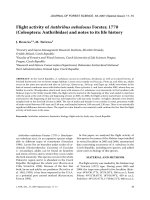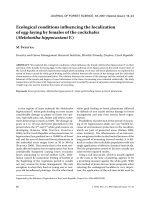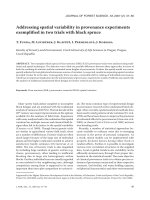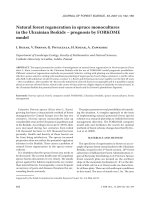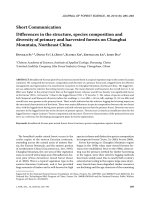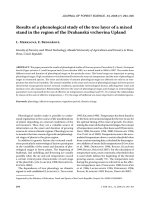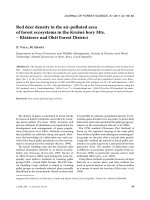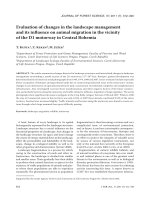Báo cáo lâm nghiệp: "Ecological light measurement in forests using the light degradation effect in hydrogenated amorphous silicon(a-Si:H)" pot
Bạn đang xem bản rút gọn của tài liệu. Xem và tải ngay bản đầy đủ của tài liệu tại đây (721.93 KB, 13 trang )
Original
article
Ecological
light
measurement
in
forests
using
the
light
degradation
effect
in
hydrogenated
amorphous
silicon
(a-Si:H)
C Ammer
G
Krötz
2
1
Lehrstuhl für
Waldbau
und
Forsteinrichtung
der
Ludwig-Maximilians-Universität
München,
Hohenbachernstr.
22,
85354
Freising;
2
Daimler Benz AG,
Postfach
800465,
81663
München,
Germany
(Received
29
August
1996;
accepted
17
February
1997)
Summary —
A
method
is
presented
for
ecological
light
measurements
in
forests
based
on
the
prin-
ciple
that
light
produces
electrically
active
defects
within
the
mobility
gap
in
semiconductors
from
hydrogenated
amorphous
silicon
(a-Si:H),
causing
measurable
changes
in
the
photoconductivity
of
the
semiconductor.
A
comparison
with
measurements
of
the
relative
illuminance
in
mixed
montane
forests
led
to
reasonable
results.
Suitability
for
field
experiments,
drawbacks
and
possible
improve-
ments
of
this
low-cost
integrating
measurement
method,
which
requires
no
external
energy
source,
are
discussed
at
length.
radiation
/
mixed
forests
/
amorphous
silicon
Résumé —
Mesure
de
la
lumière
en
forêts
au
moyen
de
la
dégradation
par
la
lumière
du
sili-
cium
amorphe
hydrogéné
(a-Si:H).
Une
méthode
est
présentée
pour
la
mesure
de
la
lumière
en
forêts,
basée
sur
l’utilisation
de
semiconducteurs
à
base
de
silicium
amorphe
hydrogéné
(a-Si:H).
Une
com-
paraison
avec
la
mesure
de
l’éclairement
relatif
dans
des
forêts
mélangées
de
montagne
conduit
à
des
résultats
raisonnables.
Les
défauts
et les
améliorations
possibles
de
cette
méthode
peu
coûteuse
pour
des
mesures
intégrées,
ne
nécessitant
pas
de
source
extérieure
d’énergie,
sont
discutés
en
détail
par
les
auteurs.
lumière
/
forêts
mélangées
/
silicium
amorphe
*
Correspondence
and
reprints
Tel:
(49)
2161 714686;
fax: (49)
2161 714646
INTRODUCTION
Countless
field
tests
have
shown
that
under
natural
conditions
the
crucial
factor
in
plant
growth,
ie,
the
factor
determining
photo-
synthesis
capacity,
in
particular
in
con-
junction
with
sufficient
amounts
of
water
and
nutrients,
is
the
radiation
in
the
approxi-
mately
400-700
nm
waveband
(Fuchs
et
al,
1977;
Benecke
et
al,
1981).
As
early
as
1877
Hartig
considered
light
as
"the
most
impor-
tant
driving
force
in
plant
life",
and
nume-
rous
other
scientists
(see
Zederbauer,
1907;
Ramann,
1911;
Knuchel,
1914)
have
since
developed
a
great
number
of
methods
for
measuring
light
(though
first
in
the
range
sensitivity
of
the
human
eye,
ie,
380-760
nm).
However,
to
this
day
light
measurements
in
plants
have
always
been
considered
"extre-
mely
complicated"
(Anderson, 1964)
and
problematic
on
account
of
various
details,
which
Brunner
(1994)
characterized
as
fol-
lows
(see
also
Baldocchi
and
Collineau,
1994):
problem
No
1:
determination
of
direct
and
diffuse
radiation;
problem
No
2:
spatial
variation
of
radiation
(affected
by
stand
height
and
structure,
or
seasons);
problem
No
3:
time
variation
of
radiation
(daily,
seasonal
and
long-term
variations);
problem
No
4:
spectral
changes
in
radiation
within
the
stand;
problem
No
5:
correct
evaluation
of
inci-
dent
radiation
with
regards
to
photosynthe-
sis.
The
development
of
PAR-sensors
for
measuring
photon
fluxes
based
on
surfaces
with
spectral
sensitivities
adapted
to
pho-
tosynthesis
(McCree,
1972;
Szeicz,
1975;
Dohrenbusch,
1995;
Dohrenbusch
et
al,
1995)
has
made
available
measuring
ins-
truments
that
deal
effectively
with
the
above
problems
and
have
become
standard
equip-
ment
in
ecophysiological
research
(Brun-
ner,
1994).
However,
for
measurements
in
forests
it
is
imperative
that
as
many
sample
tests
as
possible
be
taken
on
account
of
the
great
spatial
and
time
variations
in
radia-
tion.
Only
with
many
sensors
operating
at
the
same
time
can
variations
in
radiation
be
broken
down
into
spatial
and
time
compo-
nents
(Salminen
et
al,
1983).
This
is
also
the
case
for
parallel
measurements
of
many
individual
plants
or
parts
of
plants.
In
these
cases
"the
expense
of
the
logging
and
ana-
lysis
data
and
the
problems
of
security
and
signal
loss
due
to
damage
to
wires"
(New-
man,
1985)
can
restrict
the
use
of
the
pre-
viously
mentioned
sensors.
For
these
spe-
cial
purposes
different
low
cost
sensors
have
been
developed
in
the
past
(eg,
Friend,
1961;
Newman,
1985;
Chartier
et
al,
1989;
Pon-
tailler,
1990).
In
the
following
a
report
is
given
on
first
tests
using
a
simple
integrating
measurement
method
without
the
use
of
an
external
energy
source,
which
might
also
be
suitable
for
these
objectives.
METHODS
Principle
This
method
is
based
on
the
realization
that
light
in
amorphous
semiconductors,
such
as
hydroge-
nated
amorphous
silicon
(a-Si:H),
produces
elec-
trically
active
defects
within
the
mobility
gap.
In
the
literature
this
is
known
as
the
Stae-
bler-Wronski
effect
(Staebler
and
Wronski,
1977).
The
defects
induced
by
the
action
of
light
are
free
silicon
compounds
not
saturated
by
an
hydrogen
atom,
the
so-called
’dangling
bonds’.
The
origin
of
’dangling
bonds’
(DB)
from
intact
silicon-silicon
compounds
has
been
the
subject
of
numerous
publications
in
recent
years
(see
Stutzman
et
al,
1984).
The
present
report
des-
cribes
how
the
accumulation
of
light-induced
defects
in
a-Si:H
was
used
for
the
development
of
a
low-cost,
integrating
detector.
The
measuring
unit
is
photoconductivity
σ
ph
of
thin
films
coated
with
a-Si:H.
For
low
light
(≤
10 mW/cm
2)
photoconductivity
is
inversely
proportional
to
the
number
of
defects
N
DB
within
the
a-Si:H:
Thus,
the
variation
in
photoconductivity
can
be
used
as
a
unit
for
the
number
of
defects
induced
by
incident
light.
The number
of
defects
within
the
a-Si:H
cau-
sed
by
illumination
is
proportional
to
the
third
root
of
illumination
time
t
and
to
the
square
of
the
third
root
of
incident
light
intensity
I:
Under
certain
preconditions
the
variations
in
photoconductivity
permit
conclusions
as
to
the
amount
of
light
absorbed
by
a-Si:H.
In
the
case
of
ecological light
measurements
intensities
vary
constantly
and
absolute
values
for
absorbed
radia-
tion
are
difficult
to
obtain
by
this
method.
Howe-
ver,
relative
statements
are
possible
on
incident
light
intensity
at
different
sampling
points
in
the
stand
where
similar
variation
profiles
of
light
intensity
at
different
levels
exist.
Material
and
sample
preparation
The
degradation
medium
was
thin
films
(approxi-
mately
0.5
mm)
from
a-Si:H.
Hydrogenated
amorphous
silicon
is
a
semiconductor
with
a
mobility
gap
of
about
1.7
eV
and
is
deposited
from
silan
in
a
plasma
process
(PECVD-process,
ie,
plasma
enhanced
chemical
vapour
deposi-
tion)
(LeComber
and
Spear,
1985).
The
deposi-
tion
is
made
onto
flat
glass
screens
made
from
corning
glass
(CG
7059)
approximately
50
x
50
mm
and
0.8
mm
thick.
In
an
evaporation
system
16
aluminium
contact
pairs
about
0.3
mm
thick
are
applied
with
the aid
of
steel
shadow
masks.
The
area
for
each
contact
is
about
2 x
5 mm
and
the
contact
pairs
are
placed
at
a
distance
of
1
mm
from
each
another.
After
the
evaporation
pro-
cess
the
glass
substrate
is
divided
with
a
dia-
mond
cutter
into
samples
approximately
10
mm
2.
Each
square
holds
a
contact
pair
between
which
the
photoconductivity
of
the
thin
a-Si:H
film
can
be
measured.
Figure
1
is
a
schematic
represen-
tation
of the
samples
for
photoconductivity
mea-
surements
and
contact
generation
during
the
mea-
suring
process.
Measuring
procedure
The
unit
determining
light
absorption
by
the
samples
is
the
change
in
photoconductivity.
This
has
to
be
determined
before
and
after
exposing
the
samples
to
light
and
is
carried
out
according
to
the
set-up
shown
in
figure
2.
This
consists
of
a white
light
source
(halogen
lamp,
250
W),
a
lens,
a
ground
glass
screen
for
homogeneous
illu-
mination
of
the
samples
and
a
sample
clamp.
The
latter
is
designed
to
permit
a
quick
exchan-
ging
of
samples
so
that
even
large
numbers
of
samples
can
be
measured
within
a
reasonably
short
period
of
time.
Upon
completion
of
both
measurements
the
radiation
absorption
of
a
sample
can
be
expres-
sed
in
terms
of
the
relative
change
in
sample
photoconductivity:
where:
σ
Ph
= k(Jlight
-
J
dark
);
k
= geometry
factor;
J
light
= light
current;
J
dark
=
dark
current;
t
=
time
before
exposure
to
light;
t+1
I
= time
after
expo-
sure
to
light.
The
photoconductivity
measurements
were
performed
using
a
Hewlett
Packard
picoampe-
remeter
HP
4140B.
A
constant
voltage
of
100
V
was
applied
to
the
aluminium
contacts
of
the
samples
during
the
current
measurements.
Experimental
test
in
forest
Immediately
after
completing
the
first
measu-
ring
step
four
samples
were
placed
in
a
5
x
4
cm
plexiglass
box,
which
was
sealed
water
tight
with
silicon
paste,
wrapped
in
aluminium
foil
and
thus
transported,
in
total
darkness,
to
a
research
area
pursued
by
the
Chair
for
Silviculture
and
Forest
Inventory
(80
samples
in
20
boxes
in
total).
This
is
a
mixed
montane
forest,
about
110
years
old
with
a
stand
consisting
of
spruce
(Picea
abies
(L)
Karst),
fir
(Abies
alba
Mill),
beech
(Fagus
sylvatica
L)
and
maple
(Acer pseudoplatanus
L)
(45,
30,
20
and
5%,
respectively)
at
about
950
m
above
sea
level
near
the
small
town
of Ruhpol-
ding
(47° 45’
N,
13°
39’
E,
Germany).
The
entire
stand
had
been
divided
into
ten
subplots,
which
showed
distinct
variations
in
canopy
density,
as
a
consequence
of
different
silvicultural
treatments.
This
stand
is
part
of
an
interdisciplinary
research
programme
started
in
1976
to
investigate
the
effects
of
different
eco-
logical
factors
on
natural
regeneration
(see
Bur-
schel
et
al,
1992).
Luxmeter
data
at
1.5
m
above
ground
for
a
number
of the
permanently
mar-
ked
sample
points
(centre
points
of
1
m2
circular
sampling
units
for
natural
regeneration
invento-
ries)
were
available
from
the
last inventory
car-
ried
out
on
these
plots
in
1993.
These
had
been
made
with
instruments
by
BBC-Goerz-Metra-
watt in
Nürnberg.
Since
relative
values
had
pro-
ved
to
be
independent
of
exterior
brightness
in
diffuse
light
only
(Mitscherlich
et
al,
1967;
von
Lüpke,
1982;
Dohrenbusch,
1987) measurements
were
made
exclusively
under
overcast
skies
in
August
between
11
am
and
2
pm
Central
Euro-
pean
Summer
Time.
Taking
into
account
the
simultaneous
measurements
(by
radio
signal)
on
open
spaces,
relative
illuminance
was
calcula-
ted
for
each
sampling
point
as
The
plexiglass
boxes
containing
the
samples
were
mounted
on
wooden
poles
1.5
m
above
the
ground
at
the
centre
of
20
selected
circular
sam-
pling
units.
In
order
to
cover
the
greatest
pos-
sible
range
of
irradiance,
five
boxes
(each
with
four
samples)
were
exposed
on
subplots
that
had
been
subjected
to
different
silvicultural
treat-
ments
(table
I
). A
few
sampling
units
with
iden-
tical
light
conditions
were
selected
for
a
cross-
check
of
measuring
results.
As
photoconductivity
is
known
to
remain
unaffected
by
further
radiation
once
maximum
defect
density
has
been
reached
(Park
et
al,
1989)
we
tried
to
find
out
in
a
preliminary
test
whe-
ther
this
saturation
point
in
defect
density
would
be
reached
within
a
period
of
6
weeks
under
exclusively
diffuse
radiation
conditions
(samples
exposed
to
the
north
of
a
long-term
shading
wall).
As
figure
3
shows,
this
was
not
the
case.
From
the
assumption
that
this
point
would
have
been
rea-
ched
under
more
intense
radiation
conditions,
ie,
with
direct
radiation
components,
a
test
period
of
about
5
weeks
for
the
actual
tests
was
deduced.
After
exposure
on
site
for
approximately
53
300
min
(from
29
July
to
4
September
1994)
the
samples
were
collected,
blacked
out
again
and
taken
back
to
the
laboratory
for
renewed
mea-
surements
of
photoconductivity.
RESULTS
AND
DISCUSSION
Table
I
represents
mean
values
and
stan-
dard
deviations
obtained
from
four
samples
each,
their
respective
sites
and
the
compa-
rative
values
for
relative
illuminance
(RI)
measured
in
1993.
As
is
evident
from
figure
4,
which
plots
the
variation
coefficient
for
measured
changes,
measurements
proved
to
be
relati-
vely
uniform
for the
entire
light
intensity
range
sampled
in
this
investigation.
Figure
5
shows
that
the
determination
of
relative
variations
in
photoconductivity
is
suitable
also
for
describing
the
increase
in
relative
illuminance
with
decreasing
canopy
density
as
measured
by
a
luxmeter.
This
is
particularly
true
if
the
two
measuring
points
exposed
to
the
most
intense
radiation
are
ignored
(black
line).
A
linear
relationship
then
exists
between
the
two
measuring
values.
The
distinct
change
in
the
regres-
sion
curve
(broken
line)
obtained
when
all
the
measuring
points
are
taken
into
account
can
probably
be
explained
by
the
fact that
the
samples
at
the
measuring
points
exposed
to
the
greatest
amount
of
radiation
had
already
reached
maximum
defect
density
before
the
tests
had
been
completed
and,
thus,
there
was
no
further
appreciable
radia-
tion
effect.
However,
it
must
not
be
overlooked
that,
apart
from
the
common
tendencies
described
above,
the
two
measuring
methods,
provided
maximum
defect
density
of
the
samples
is
not
reached,
also
show
ranges
with
great,
system-related
variations
in
measuring
results.
In
particular
in
the
very
densely
to
densely
canopied
range
there
were
diffe-
rences
in
the
relative
changes
in
photocon-
ductivity
for
similar
relative
illuminance
conditions.
This
suggests
the
influence
of
direct
radiation
from
sunflecks,
which
was
only
taken
into
account in
our
method.
This
predominantly
direct
radiation
component
(Smith
and
Morgan,
1981)
can
be
the
source
of
considerably
increased
absorbed
radia-
tion
at
individual
sample
points
(Gross
and
Chabot,
1979;
Pearcy
et
al,
1987;
Chazdon,
1988;
Pearcy,
1988).
An
indication
that
our
method
actually
permits
a
sufficient
description
of
radiation
conditions
crucial
to
plant
photosynthesis,
by
taking
into
account
the
direct
radiation
com-
ponent,
is
given
by
the
comparison
of
two
sample
points
at
the
moderate
shelterwood
subplot,
for
which
almost
identical
relative
illuminance
(RI)
values
had
been
determined
(sample
points
Nos
6 and
9,
data
not
shown).
Sample
point
No
6
was
identified
as
having
the
more
favourable
radiation
conditions
based
on
the
measured
changes
in
photo-
conductivity
and
had
both
considerably
grea-
ter
amounts
of
biomass
and
higher
plant
density
than
sample
point
9.
Further
com-
parisons
of
this
kind
were
not
possible
owing
to
a
lack
of
plants
(in
very
dark
ranges)
or
browsing
by
deer
(numerous
sample
points
had
no
protective
fencing).
No
conclusive
assessment
of
the
above
method
for
ecological
light
measurements
is
possible
owing
to
the
very
few
measure-
ments,
the
lack
of
comparison
with
measu-
rement
data
of
identical
observation
periods
and
data,
eg,
from
PAR-sensors
(regretta-
bly
not
available).
The
latter
objection
is
very
grave,
since
authors
such
as
Pearcy
(1989)
emphasise
that
measurements
of
pho-
tosynthesis-relevant
radiation
on
a
photo-
metric
basis
is
worthless.
In
spite
of
this
contradiction
Dohrenbusch
( 1987)
and
Brunner
(1993)
could
show
that
for
ecolo-
gical,
but
not
for
physiological,
purposes
the
measurement
of
the
relative
illuminance
is
sufficient
in
many
cases.
Although
the
use
of
luxmeters
for
calibration
restricts
a
complete
dicussion
of
problems
Nos
1,
3
and
4
outlined
in
the
Introduction,
in
the
following
section
a
preliminary
evaluation
of
the
suitability
of
our
method
is
tested.
Determination
of
diffuse
and
direct
radiation
components
In
contrast
to
the
method
of
Wagner
and
Nagel
(1992)
and
Wagner
(1994),
who
determine
solar
radiation
from
fish-eye
pho-
tos
with
imaging
software,
our
system
regrettably
allows
no
break-down
into
dif-
fuse
and
direct
radiation
components.
A
dif-
ferent
effect
of
diffuse
and
direct
radiation
on
the
silicon
samples
could
be
caused
by
the
fact
that
in
the
case
of
diffuse
incident
light
interference
phenomena
on
the
thin
a-
Si:H
films
might
have
to
be
taken
into
account.
This
could
perhaps
be
avoided
if
the
a-Si:H
films
are
deposited
onto
ground
substrates.
It
is
an
advantage,
however,
that
the
changes
in
photoconductivity
of
the
samples
are
the
result
of
the
actual
total
inci-
dent
radiation.
This
implies
that
it
could
be
possible
to
discover
factors
that
affect
plant
growth
that
are
being
overlooked
when
one
radiation
component
only
is
being
taken
into
account
throughout.
An
example
of
this
could
be
the
effect
of
topography,
which
only
affects
the
direct
radiation
component
(Baumgartner,
1960; Biederbick,
1992).
As
in
other
integrating
measurement
sys-
tems,
it
is
also
conceivable
for
this
method
that
the
sum
of
light
energy
measured
is
not
necessarily
identical
to
the
light
energy
actually
used
by
the
plant
(Dohrenbusch
et
al,
1995).
Thus,
while
it
is
possible
to
mea-
sure
too
little
(Young
and
Smith,
1979)
or
excess
radiation
(photoinhibition,
heat
stress)
(Chazdon,
1988),
plants
may
not
be
able
to
fully
use
either
for
photosynthesis.
Errors
caused
by
the
above
should,
however,
not
be
too
great,
at
least
not
in
the
case
of
intense
radiation,
since
a
linear
increase
in
photo-
synthetic
response
in
relation
to
available
light
is
assumed
to
exist
(Larcher,
1994)
in
plant
stands
in
contrast
to
individual
leaves.
Spatial
and
time
variations
The
determination
of
spatial
variations
of
the
light
regime
in
plant
stands
could
be
one
field
of
application
where
our
method
is
expected
to
have
considerable
advantage
over
conventional
methods.
In
1911
Ramann
emphasized
that:
"Light
measurements
in
forests
are
subject
to
constantly
changing
illumination
and
require
a
great
number
of
individual
measurements
rather
than
great
accuracy".
Since
the
size
of
the
sample
test
and
the
duration
of
the
measuring
period
have
considerable
influence
on
the
varia-
tions
in
the
measuring
data
(Gay
et
al,
1971;
Johannson,
1987)
it
is
recommended
for
investigations
using
PAR-sensors
that
these
be
moved
through
the
stand
on
tracks
or
conveyor
belts
(’moving
sensors’)
(Mukam-
mal,
1971;
Szeicz,
1975;
Baldocchi
et
al,
1986).
Salminen
et
al
(1983),
however,
poin-
ted
out
that
this
does
not
permit
a
break-
down
into
spatial
and
time
variations,
in
contrast
to
many
sensors
measuring
simul-
taneously.
This
could,
however,
be
achie-
ved
with
our
method
(of
course
not
in
the
case
of
short-term
spatial
variations)
and,
moreover,
with
an
optional
alignment
in
any
direction.
For
ecological
investigations
it
is
therefore
conceivable
that,
eg,
radiation
absorption
of
a
great
number
of
individual
plants
or
parts
of
plants
at
different
heights
from
the
ground
can
be
measured
and
com-
pared.
Also,
the
simultaneous
investigation
of
seasonal
variations
in
different
types
of
forest
(Chazdon,
1988)
would
be
possible.
Spectral
sensitivity
Ever
since
the
first
light
measurements
were
performed
in
forests,
it
has
always
been
pointed
out
that
the
measuring
system
must
record
not
only
the
intensity,
but
also
the
quality
of
radiation
(Zederbauer,
1907;
Coombe,
1957;
Anderson,
1964).
This
is
particularly
important
when
data
on
radia-
tion
are
seen
in
the
context
of
plant
photo-
synthesis
(Langholz
and
Häckel,
1985).
Figure
6
shows
the
relative
amount
of
opti-
cal
absorption
by
the
amorphous
silicon
(right
scale)
and
the
amount
of
transmission
by
the
plastic
boxes
in
which
the
silicon
cells
had
been
encased
(left
scale).
It
is
obvious,
that
these
two
components
alone
do
not
warrant
a
good
approach
to
the
spec-
tral
efficiency
of
photosynthesis.
Above
all
the
short-wave
break-off
edge
of
sensor
reaction
at
about
400
nm
has
to
be
achie-
ved
by
means
of
filters.
The
simplest
way
to
realize
this
could
be
to
use
containers
for
the
a-Si:H
samples
that
do
not
permit
light
transmission
below
400
nm.
The
ones
used
here
were
already
transmissive
at
300
nm
(fig
6).
The
availability
of
low-cost
sample
containers
with
the
requisite
transmission
properties
needs
to
be
checked.
If
none
are
available,
it
is
conceivable
that
thin
a-Si:H
filtering
layers
could
be
deposited
on
the
other
side
of
the
samples.
This
could
be
car-
ried
out
in
the
same
deposition
system
used
for
the
a-Si:H
films.
Another
problem
is
that
the
absorption
of
the
thin
a-Si:H
film
is
related
to
the
wave
length,
which
leads
to
an
increasingly
irre-
gular
absorption
behaviour
with
increasing
sample
thickness
and
decreasing
wave
length.
Modification
of
layer
thickness
or
bandgap
by
alloying
with
carbon
might
solve
this
problem.
Measuring
period
As
diffuse radiation
components
vary
only
very
slightly
in
the
course
of
a
vegetation
period
while
direct
ones
undergo
very
great
changes
(Anderson,
1970),
daily
totals
are
not
very
effective
and
their
validity
is
very
inferior
to
integrating
measurement
methods
applied
over
longer
periods
of
time.
The
collection
of
data
over
longer
periods
of
time
is
also
possible
with
the
method
pre-
sented
here.
However,
since
the
maximum
defect
density
of
samples
is
reached
more
quickly
under
intense
radiation
conditions,
the
measuring
duration
largely
depends
on
local
conditions.
In
any
case
the
measuring
period
will
be
at
least
several
weeks
and
thus
also
helps
to
mitigate
one
severe
draw-
back
of
our
method.
The
conversion
of
the
number
of
defects
into
energy
units
or
pho-
ton
flux
densities
is
not
possible,
while
data
on
the
relative
change
in
photoconductivity
are
neither
useful
nor
do
they
permit
com-
parisons.
It
is
therefore
necessary
to
rely
on
relative
values
that
describe
the
relative
changes
determined
in
the
stand
in
relation
to
conditions
on
a
reference
area.
While
comparisons
between
relative
values
of
areas
of
different
local
climate
are
not
satisfying,
in
addition
Anderson
(1964)
recommends
listing
the
original
measured
absolute
values.
Moreover,
it
is
disadvantageous
that
rela-
tive
values,
unless
referring
to
the
diffuse
radiation
components
only,
are
highly
dependent
on
exterior
brightness
(Mit-
scherlich
et
al,
1967;
Brunner,
1993).
Howe-
ver,
errors
arising
from
this
should
be
almost
negligible
when
taking
measurements
over
lengthy
periods
of
time
where
different
exte-
rior
brightness
conditions
are
being
taken
into
consideration.
Comparison
with
other
low-cost
sensors
or
methods
As
mentioned
in
the
Introduction,
some
other
cheap
methods
for
measuring
light
in
the
field
already
exist.
More
than
30
years
ago
Friend
( 1961 )
provided
a
description
of
the
use
of
light-sensitive
diazo
paper.
Howe-
ver,
the
correct
assessment
of
this
method
requires
a
specific
interpretation
(Bardon
et
al,
1995).
Recently
Newman
(1985),
using
silicon
photocells
and
Pontailler
(1990)
who
employed
a
gallium
arsenide
photodiode,
presented
new
methods
that
allow
suffi-
ciently
accurate
measurements.
However,
both
methods
are
restricted
in
the
number
of
sensors
measuring
simultaneously,
and
depend,
in
the
case
of
the
gallium
arsenide
photodiode,
on
an
external
energy
source.
This
also
applies
to
the
methods
of
Char-
tier
et
al
(1989)
and
Muleo
et
al
(1993),
who
also
used
amorphous
silicon,
although
in
a
deviating
way
of
measurement
(photoelec-
tric
current
compared
to
changes
in
photo-
conductivity
(as
in
this
paper)).
However,
in
particular
Chartier
et
al
(1989)
realized
a
number
of
tests
also
necessary
for
the
method
presented
here.
This
relates
above
all
to
results
concerning
the
cosine
response
and
temperature
dependence.
With
regards
to
both
factors
Chartier
et
al
(1989)
under-
lined
the
potential
of
amorphous
silicon
cells
for
ecological
light
measurements.
If
these
results
can
be
confirmed,
our
method
is
pro-
bably
favourable.
As
a-Si:H
thin
films
are
used
now
in
a
variety
of
products,
like
solar-
cells,
scanners,
etc,
commercial
manufac-
turers
are
on
the
market.
Depending
on
num-
bers
we
would
expect
that
samples
could
be
bought
in
bulk
at
low
prices
from
com-
mercial
suppliers.
A
laboratory
equipment
for
producing
the
cells
would
cost
between
300
000
and
800 000
DM.
As
the
light
generated
defects
in
the
a-
Si:H
layers
can
be
annealed
at
strongly
ele-
vated
temperatures,
the
samples
are
princi-
pally
renewable.
Nevertheless,
irreversible
processes
during
annealing
could
lead
to
a
different
starting
position
compared
to
unu-
sed
samples.
As
the
samples
are
expected
to
be
quite
cheap
if
produced
commercially,
it
would
be
recommended
to
always
use
fresh
and
unused
samples.
CONCLUSIONS
While
the
development
of
methods
such
as
PAR-sensors
or
the
computerized
evalua-
tion
of
hemispherical
photographs
(Wagner
and Nagel,
1992;
Wagner,
1994;
Easter
and
Spies,
1994)
nowadays
permits
the
deter-
mination
of
absolute
energy
values
or
pho-
ton
flux
densities,
and
is
considered
suitable
for
radiation
evaluation
in
forests,
there
are
still
only
a
few
simple
integrating
measu-
rement
methods
for
the
simultaneous
deter-
mination
of
the
radiation
utilized
by
plants
at
any
number
of
sample
points
on
a
given
area
or
within
a
single
plant.
In
the
method
presented
here
spectral
sensitivity
of
the
sensors,
the
use
of
relative
values
and
the
undefined
maximum
possible
measuring
period
still
need
to
be
improved
or
they
represent
certain
drawbacks.
However,
the
method
could
be
a
step
towards
another
suf-
ficiently
accurate
method
to
warrant
the
"compromise
between
accuracy
and
prac-
ticability"
in
field
light
measurements
demanded
by
Anderson
(1964).
ACKNOWLEDGEMENTS
The
authors
wish
to
thank
Dr
Müller
(Daimler-
Benz
AG)
for
his
suggestion,
made
many
years
ago,
to
use
the
Staebler-Wronski
effect
as
the
integrating
detection
principle
for
radiation
as
well
as
for
his
interest
in
and
support
of
this
study.
Thanks
are
also
due
to
Mr
Legner
for
his
assistance
with
the
design
and
construction
of
the
sample
clamping
device,
to
Prof
Dr
H
Mayer,
Dr
S
Wagner
and
anonymous
reviewers
for
their
critical
and
very
helpful
comments.
Last
but
not
least
many
thank
to
Mrs
H
Meier
for
the
English
translation
of
this
manuscript.
REFERENCES
Anderson
MC
(1964)
Light
relations
of
terrestrial
plant
communities
and
their
measurement.
Biol
Rev
39,
425-486
Anderson
MC
(1970)
Interpreting
the
fraction
of
solar
radiation
available
in
forest.
Agric
Meterorol 7, 19-
28
Baldocchi
D,
Collineau S
(1994)
The
physical
nature
of
solar
radiation
in
heterogeneous
canopies:
spatial
and
temporal
attributes.
In:
Exploitation
of Envi-
ronmental
Heterogenity
by
Plants:
Ecophysiolo-
gical
Process
above-
and
below
Ground
(MM
Cald-
well,
RW
Pearcy,
eds),
Academic
Press,
San
Diego,
21-71
Baldocchi
D,
Hutchison
B,
Matt
D,
McMillen
R
(1986)
Seasonal
variation
in
the
statistics
of photosynthe-
tically
active
radiation
penetration
in
an
oak-hickory
forest.
Agric
Forest
Metearol 36,
343-361
Bardon
RE,
Countryman
DW,
Hall
RB
(1995)
A
reas-
sessment
of
using
light-sensitive
diazo
paper
for
measuring
integrated
light
in
the
field.
Ecology
76,
1013-1016
Baumgartner
A
(1960)
Gelände
und
Sonnenstrahlung
als
Standortfaktor
am
Gr
Falkenstein.
Forstw
Cbl
79, 286-297
Benecke
U,
Schulze
E-D,
Matyssek
R,
Harranek
WM
(1981)
Environmental
control
of
CO
2
-assimilation
and
leaf
conductance
in
Larix
decidua
Mill.
I.
A
comparison
of
contrasting
natural
environments.
Oecologia
50,
54-61
Biederbick
K-H
(1992)
Die
direkte
Sonnenstrahlung
als
Standortfaktor.
Forstarchiv 63,
131-136
Brunner
A
(1993)
Die
Entwicklung
von
Bergmisch-
waldkulturen
in
den
Chiemgauer Alpen
und
eine
Methodenstudie
zur
ökologischen
Lichtmessung
im
Wald.
Forstl
Forschungsberichte,
Nr
128
Brunner
A
(1994)
Ökologische
Lichtmessung
im
Wald.
Forstarchiv 65, 133-138
Burschel
P,
El
Kateb
H,
Mosandl
R
(1992)
Experi-
ments
in
mixed
mountain
forests
in
Bavaria.
In:
The
Ecology
and
Silviculture
of
Mixed-species
Forests
(MJ
Kelty,
BC
Larson,
CD
Oliver,
eds),
Kluwer
Academic
Publishers,
Dordrecht,
183-215
Chartier
M,
Bonchretien
P,
Allirand
JM,
Gosse
G
(1989)
Utilisation
des
cellules
au
silicium
amorphe
pour
la
mesure
du
rayonnement
photosynthétique-
ment
actif
(400-700
nm).
Agronomie
9,
281-284
Chazdon
RL
(1988)
Sunflecks
and
their
importance
to
forest
understorey
plants.
Adv
Ecol
Res
18, 1-
63
Coombe
DE
( 1957)
The
spectral
composition
of
shade
light
in
woodlands.
J
Ecol
45,
823-830
Dohrenbusch
A
(1987)
Kann
die
"relative
Beleuch-
tungsstärke"
die
Lichtverhältnisse
im
Wald
zuverlässig
charakterisieren?
Forstarchiv
58,
24-
27
Dohrenbusch
A
(1995)
Überlegungen
zur
Optimie-
rung
der
Strahlungsmessung
im
Wald.
Allg
Forst-
u J Ztg
166,
109-114
Dohrenbusch
A,
Kranigk
J,
Pryor
D
(1995)
Entwick-
lung
und
Bau
eines
Lichtmeßgerätes
zur
Erfassung
der
photosynthetisch
nutzbaren
Strahlung.
Allg
Forst-u J Ztg
166,
154-160
Easter
MJ,
Spies
TA
(1994)
Using
hemispherical
pho-
tograph
for
estimating
photosynthetic
photon
flux
density
under
canopies
and
in
gaps
in
Douglas-fir
forests
of
the
Pacific
Northwest.
Can
J
For
Res
24,
2050-2058
Friend
DTC
(1961)
A
simple
method
of
measuring
integrated
light
values
in
the
field.
Ecology
42, 577-
580
Fuchs
M,
Schulze
E-D,
Fuchs
MJ
(1977)
Spatial
dis-
tribution
of
photosynthetic
capacity
and
perfor-
mance
in
a
mountain
spruce
forest
of
Northern
Ger-
many.
Oecologia
29, 329-340
Gay
LW,
Knoerr
KR,
Braaten
MO
(1971)
Solar
radia-
tion
variability
on
the
floor
of
a
pine
plantation.
Agric
Meterorol 8,
39-50
Gross
LJ,
Chabot
BF
(1979)
Time
course
of
photo-
synthetic
response
to
changes
in
incident
light
energy.
Plant Physiol 63,
1033-1038
Hartig
T
(1877)
Photometrisches.
Allg
Forst-
u
J
Ztg
53,
35-36
Johannson
T
(1987)
Irradiance
in
thinned
Norway
spruce
(Picea
abies)
stands
and
the
possibilities
to
prevent
suckers
of
broadleaved
trees.
For
Ecol
Manage
20,
307-319
Knuchel
H
(1914)
Spektrometrische
Untersuchungen
im
Walde.
Mitt
d
Schweiz
Centralanstalt f d
Forstl
Versuchswesen
11,
1-94
Langholz
H and
Häckel
H
(1985)
Messungen
der pho-
tosynthetisch
aktiven
Strahlung
und
Korrelationen
mit
der
Globalstrahlung.
Meteorol
Rdsch
38,
75-
82
Larcher
W
(1994)
Ökophysiologie
der
Pflanzen,
Leben
Leistung
und
Strßbewältigung
in
ihrer
Umwelt,
5.
Völlig
neubearb
Auflage.
Eugen
Ulmer,
Stuttgart
LeComber
PG,
Spear
WE
(1985)
Doped
amorphous
semiconductors
in
amorphous
Semiconducters.
In:
Topics
in
Applied
Physics
(MH
Brodsky,
ed),
Sprin-
ger,
Berlin,
251-285
Lüpke
B
von
(1982)
Versuche
zur
Einbringung
von
Lärche
and
Eiche
in
Buchenbestände.
Schriften
a
d
Forstl
Fakultät
der
Universität
Göttingen
u
d
Nie-
dersächsischen
Forstl
Versuchsanstalt,
Bd
74
McCree
KJ
(1972)
Test
of
current
definitions
of pho-
tosynthetically
active
radiation
against
photosyn-
thesis
data.
Agric
Meterorol 10,
443-453
Mitscherlich
G,
Künstle
E,
Lang
W
(1967)
Ein
Bei-
trag
zur
Frage
der
Beleuchtungsstärke
im
Bestand.
Allg
Forst-
u
J Ztg
138, 213-223
Muleo
R,
Tellini
A,
Masetti
C,
Morini S
(1993)
Low
cost
sensors
to
measure
solar
radiation
in
woody
plant
communities.
Adv
Hort
Sci
7, 117-121
Mukammal
El
(1971)
Some
aspects
of
radiant
energy
in
a
pine
forest.
Arch
Met
Geoph
Ser
B
19, 29-52
Newman
SM
(1985)
Low
cost
sensor
integrators
for
measuring
the
transmissivity
of
complex
canopies
to
photosynthetically
active
radiation.
Agric
For
Meterol
35,
243-254
Park
HR,
Liu
JZ,
Wagner
S
(1989)
Saturation
of
the
light-induced
defect
density
in
hydrogenated
amor-
phous
silicon.
Appl
Phys
Lett
55, 2658-2660
Pearcy
PW
(1988)
Photosynthetic
utilisation
of
light-
flecks
by
understory
plants.
Aust
J
Plant
Physiol
15, 223-238
Pearcy
PW
(1989)
Radiation
and
light
measurement
In:
Plant
Photosynthetical
Ecology
(RW
Pearcy,
JR
Ehleringer,
HA
Mooney,
PW
Rundel,
eds),
Chapman
&
Hall,
97-116
Pearcy
RW,
Chazdon
RC,
Kirschbaum
MUF
(1987)
Photosynthetic
utilisation
of
lightflecks
by
tropi-
cal
forest
plants.
In:
Progress
in
Photosynthesis
Research,
vol
IV
(J
Briggens,
ed),
Martinus
Nij-
hoff
Publishers,
Dordrecht,
257-260
Pontailler J-Y
(1990)
A
cheap
quantum
sensor
using
a
gallium
arsenide
photodiode.
Functional
Ecol
4,
591-596
Ramann
E
(1911)
Lichtmessungen
in
Fichtenbeständen.
Allg
Forst-
u
J Ztg
87, 401-406
Salminen
R,
Hari
P,
Kellomäki
S,
Korpilalti
E,
Koti-
ranta
M,
Sievänen
R
(1983)
A
measuring
system
for
estimating
the
frequency
distribution
of irradiance
within
plant
canopies.
JAppl
Ecology
20,
887-895
Smith
H,
Morgan
DC
(1981)
The
spectral
characteris-
tics
of the
visible
radiation
incident
upon
the
surface
of the
earth. In:
Plants
and
the
Daylight
Spectrum
(H
Smith,
ed),
Academic
Press,
London,
3-20
Staebler
DL,
Wronski
CR
(1977)
Reversible
conduc-
tivity
changes
in
discharge-produced
amorphous
Si.
Appl
Phys
Lett
31, 292-294
Stutzmann
M,
Jackson
WB,
Tsai
CC
(1984)
Light-
induced
metastable
defects
in
hydrogenated
amor-
phous
silicon:
A
systematic
study.
Phys
Rev
B
32,
23-47
Szeicz
G
(1975)
Instruments
and
their
exposure.
In:
Vegetation
and
the
Atmosphere
Vol
1
Principles
(JL
Monteith,
ed),
Academic
Press,
London,
229-
273
Wagner
S,
Nagel
J (1992)
Ein
Verfahren
zur
PC -
ges-
teuerten
Auswertung
von
Fish -
eye -
Negativfo-
tos
für
Strahlungsschätzungen.
Allg
Forst-
u
J
Ztg
163, 110-116
Wagner
S
(1994)
Strahlungsschätzung
in
Wäldern
durch
hemispärische
Fotos-Methode
und Anwen-
dung.
Ber
d
Forschungszentrums
Waldökosysteme
Reihe A, Bd
123
Young
DR,
Smith
WK
(1979) Influence
of sunflecks
on
the
temperature
and
water relations
of two
subalpine
understory
congeners.
Oecologia
43,
195-205
Zederbauer
E
(1907)
Das
Lichtbedürfnis
der
Waldbäume
und
die
Lichtmessmethoden.
Cbl
Ges
Forstwesen
33,
325-330
